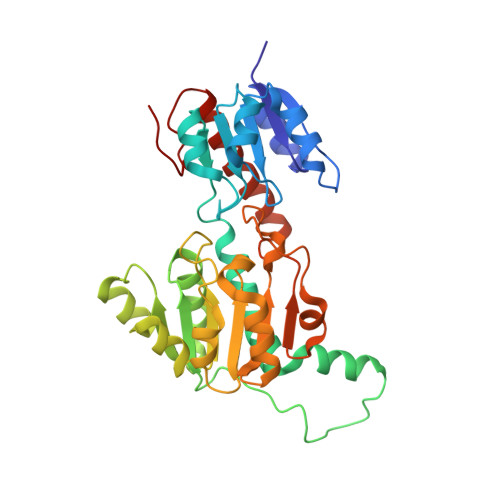Chemical rescue and inhibition studies to determine the role of arg301 in phosphite dehydrogenase.
Hung, J.E., Fogle, E.J., Garg, N., Chekan, J.R., Nair, S.K., van der Donk, W.A.(2014) PLoS One 9: e87134-e87134
- PubMed: 24498026
- DOI: https://doi.org/10.1371/journal.pone.0087134
- Primary Citation of Related Structures:
4NU5, 4NU6 - PubMed Abstract:
Phosphite dehydrogenase (PTDH) catalyzes the NAD(+)-dependent oxidation of phosphite to phosphate. This reaction requires the deprotonation of a water nucleophile for attack on phosphite. A crystal structure was recently solved that identified Arg301 as a potential base given its proximity and orientation to the substrates and a water molecule within the active site. Mutants of this residue showed its importance for efficient catalysis, with about a 100-fold loss in k cat and substantially increased K m,phosphite for the Ala mutant (R301A). The 2.35 Å resolution crystal structure of the R301A mutant with NAD(+) bound shows that removal of the guanidine group renders the active site solvent exposed, suggesting the possibility of chemical rescue of activity. We show that the catalytic activity of this mutant is restored to near wild-type levels by the addition of exogenous guanidinium analogues; Brønsted analysis of the rates of chemical rescue suggests that protonation of the rescue reagent is complete in the transition state of the rate-limiting step. Kinetic isotope effects on the reaction in the presence of rescue agents show that hydride transfer remains at least partially rate-limiting, and inhibition experiments show that K i of sulfite with R301A is ∼400-fold increased compared to the parent enzyme, similar to the increase in K m for phosphite in this mutant. The results of our experiments indicate that Arg301 plays an important role in phosphite binding as well as catalysis, but that it is not likely to act as an active site base.
Organizational Affiliation:
Department of Chemistry, University of Illinois at Urbana-Champaign, Urbana, Illinois, United States of America.
















